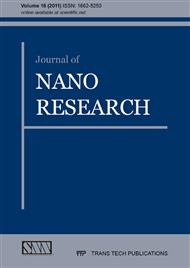p.1
p.9
p.15
p.21
p.29
p.37
p.43
p.49
Fabrication and Characterization of Si Nano-Columns by Femtosecond Laser
Abstract:
We fabricated Si Nano-columns by a femtosecond laser with various wavelengths and process parameters, whilst the specimen was submerged in water. The experiments were carried out by three types of wavelengths i.e. 1030 nm, 515nm, 343nm, with 500 fs laser pulses. The scales of these spikes are much smaller than micro spikes that are constructed by laser irradiation of silicon surface in vacuum or gases like SF6, Cl2. The Si nano-columns of 300 nm or less in width were characterized by SEM measurements. The formation of these Si Nano-columns that were revealed by SEM observation, indicates chemical etching with laser ablation occurred when surface exposed by laser beam. We observed 200 nm spikes height at the center of laser beam profile and the ones uniform in height at lateral incident area.
Info:
Periodical:
Pages:
15-20
Citation:
Online since:
January 2012
Keywords:
Price:
Сopyright:
© 2011 Trans Tech Publications Ltd. All Rights Reserved
Share:
Citation:


